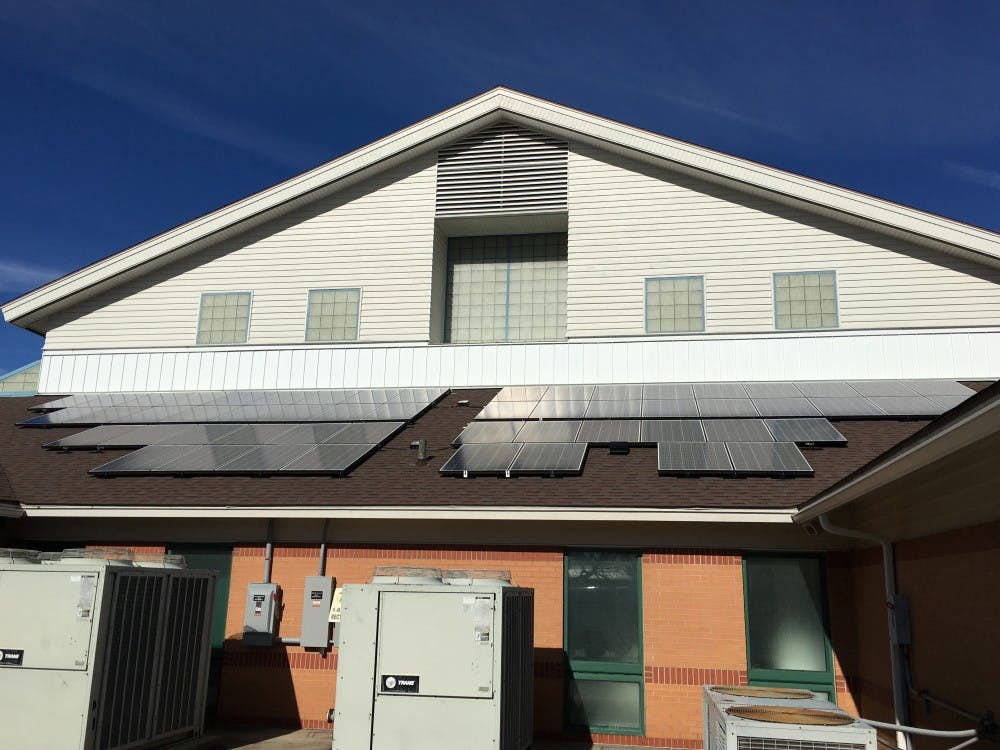Four organizations in Muncie are now able to be powered by sunlight.
The Solar Uniting Neighbors (SUN) Program gave four local organizations — Youth Opportunity Center (YOC), Kennedy Library, ecoREHAB of Muncie, Inc. and the Unitarian Universalist Church of Muncie — grants to help purchase solar panels to offset electrical costs.
Ball State has been involved with ecoREHAB of Muncie, Inc. since 2009 when it started as a design build studio through the Department of Architecture.
Ball State owns and operates a model house where classes and offices are located. The SUN grant, along with a matched donation from Mutual Bank, provided funding to put eight solar panels on top of the house. Eventually, students will be able to get on top of the roof and look at the system. Seven of the panels are installed currently.
“Students have been watching the installation to get a better understanding of how systems work and the different components that make a complete solar installation,” Jonathan Spodek, an architecture professor, said. “We will have a dashboard, so the students can look at that at any time and can see how well the system is working and if it’s working to the capacity that we sized it for.”
Spodek serves as the connection between Ball State and ecoREHAB and hopes the model house will be able to provide an accessible installation so that people can see how a solar panel system operates.
“We wanted to have a place where not just Ball State students, but the broader Muncie community could come and see an installation up close and understand how it goes together,” Spodek said. “We see the panels on the road, but we don’t really understand how they work.”
For YOC, an electrical bill is about $230,000 year and is forecasted to increase 32 percent over the next eight years, which was a concern to Jeff Helm, IT and Facilities director.
“Because we are a not-for-profit, [we] would rather spend the resources that we are entrusted with to directly help kids rather than on overhead,” Helm said. “We think it’s a great demonstration project because of the kids and families that we work with to demonstrate good stewardship and being a good member of the community.”
YOC provides residential and behavioral services to at-risk youth from 30 counties in Indiana and has been working on energy conservation projects since 2010.
There are two types of solar systems: photovoltaic (PV), which only generates electricity, and thermal, which heats water. YOC utilizes 55 PV panels. It started researching the panels in 2013, and the grant, which was available in 2014, paid half of the cost.
The panels power 15 percent of the central services facility, and YOC plans to buy more panels when a grant or donor is interested in funding it, Helm said. With the wiring infrastructure already in place, adding more panels would be cheap compared to the original project.
Helm said YOC brings a practical view of solar energy. Rather than focusing on the broader concepts of the benefits of solar energy, it focuses on things like what electrical wiring and permits are required in order to get solar energy.
“We can kinda talk through and go back [to where our panels are] and say, ‘Here’s the steps involved.’ And I think, for some organizations, that makes it a little more attainable,” Helm said. “It’s not just a pie in the sky dream ... it gets it down to actionable steps.”
Ginny Niles, executive director for Muncie Public Library, applied for the SUN grant for Kennedy Library because it was the most visible of the four library locations. Because education is a large part of the grant, Niles thought Kennedy’s visibility would be an asset to that component.
Kennedy Library has 80 panels that power 15-20 percent of the library. Instead of installing the panels on the roof like YOC, Niles opted for a carport with solar panels on top. Cars are not involved in the solar collection, it is simply a structure to shelter cars while energy is collected on the top of the carport.
“When one drives down McGalliard, the solar array on the roof of the carport is immediately identifiable as a solar energy collector," Niles said. "It is a conversation starter, and people become curious."
Kennedy Library will partner with other organizations and host a series of programs in April about alternative energy options for homes and businesses with a vendor fair at the end of April. Niles said the library “seeks to apply technology in creative and educational ways” while providing education opportunities.
“We all need to learn about and consider renewable energy and nonpolluting energy options,” Niles said. “Putting technology in the hands of our community and raising awareness about its uses at home, school and work is part of our mission.”





